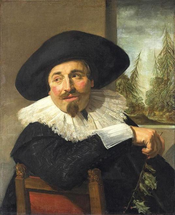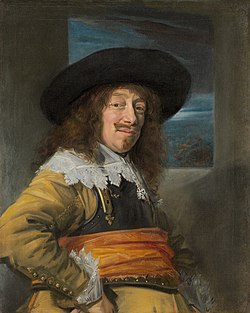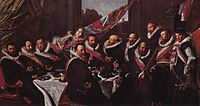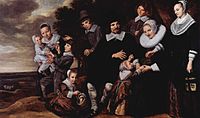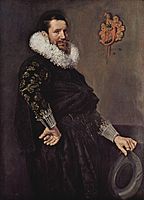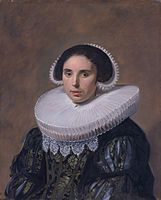Frans Hals
Frans Hals (Antwerp, 1582 or 1583-Haarlem, August 26, 1666) was a Dutch painter belonging to the Dutch Baroque school. He is one of the great masters in the art of portraiture. He arouses great admiration for the brilliance in the representation of light and the freedom in the handling of the brushes, with a rapid and loose brushstroke preceding impressionism.
Biography
Shadows in her biography
The scarcity of documents and the complete absence of Frans Hals's personal writings mean that his personality and his life remain somewhat in the dark. There are several hypothetical dates of his birth, which could have been around 1582-1583, deduced from the age that his biographers calculate that he would have been when he died, although he was certainly born in the Flemish city of Antwerp. He was the son of Franchois Fransz Hals von Mechelen (1542-1610), a cloth merchant, and his second wife Adriaentje van Geertenryck. Like many, after the fall of the city in 1584-85, the family abandoned it, moving to Haarlem. Already in 1591 his brother Dirck was baptized there, who would also dedicate himself to painting.
After the fall of Antwerp at the hands of Spanish troops in the Eighty Years' War, which led to the fragmentation of Flanders, his family settled in Haarlem, in the north, where his parents were from. In this city Hals lived all his life. The painter's biography runs parallel to the independence of the Netherlands from the Spanish monarchy.
The most recent studies have banished the idea that the painter had from ancient times about a libertine life and an incorrigible addiction to alcohol, based on embellished anecdotes without evidence to document them from his first biographers. Hals and his brother belonged to the literary association De Wijngaertranken (“The Wine Drinkers”) and to the Saint George civic militia, and was also a member of the house of rectors and president from 1644 of the guild of Haarlem painters. The rectitude and puritanism of these societies does not fit with the fact that Hals had known bad habits and vices.
Beginnings
The young artist entered the workshop of the Flemish painter Karel van Mander (1548–1606), who also ended up there fleeing the Spanish push in the area. The academy of this teacher dedicated his study to a mannerist technique. But at the end of the 16th century, due to the influence of Italian painting, an art of a certain classicist inspiration emerged that would be revealed in the works of the first Hals. Therefore, the influence of Van Mander in this period is not noticeable.
His emancipation from work occurred when he reached a certain artistic maturity. It coincides with his joining the Sint-Lucasgilde , the Guild of Saint Luke in 1610, a famous artists' guild from Haarlem with branches in Antwerp, Utrecht, Delft and Leiden. The oldest work by Frans Hals, whose authorship is known for sure, is the portrait of Jacobus Zaffius (1611; Frans Hals Museum, Haarlem).
It is also in 1610 that he married Anneke Hermansz, also formerly believed that this union was not happy because some historians had documented that Hals had to appear before the courts for ill-treatment of his first wife. As biographer Seymour Slive has noted, he was due to mistaking it for another similarly named town resident. In fact, by the time the charges were filed, the painter Frans Hals did not even have a wife, Anneke having died in May 1615 shortly after the birth of her third child. In 1617, after a fleeting trip to Antwerp (perhaps to get in touch with Rubens), he married Lysbeth Reyniers, the young daughter of a fishmonger whom he had hired to look after his children, because she was already pregnant with him. eight months. Hals was a devoted father and they had eight children.
Consolidation: Between success and debts
The Dutch portraiture tradition reaches its peak with Frans Hals, managing to bring it out of silence and portraying its figures in motion. His great contribution came in 1616, with the collective portrait, Banquet of officers of the San Jorge civic militia . This commission proves that the painter had already achieved a certain reputation as an artist. From this painting, commissions became very common both from individuals and institutions.
Although Hals's work was in great demand during his lifetime, he ran into severe financial difficulties, whether due to a profligate life or having to support a large family after a second marriage to a humble woman. In addition to painting, he worked as a dealer, art restorer, and painting teacher.
As of 1640, a new turn in portraiture fashion is observed in the Nordic countries. They begin to prefer portraits with a greater air of distinction and nobility, such as those of Antonio Moro or Anthony van Dyck, where expensive clothing is represented with bright colors and very detailed brushwork. This had a significant impact on the requests of the Dutch portrait painter, who painted in a very sketchy manner and with restricted colouring. Despite this, in official artistic circles, recognition followed one another, as in 1644, when he was elected president of the Guild of Saint Luke in Haarlem.
Faced with this lack of work, Hals tried to open new paths and founded a workshop around 1650. But the company could not have been lucky because in 1652 its economy hit rock bottom. His creditors sued him on several occasions, and in that year he paid off his debt to a banker by selling his belongings. The seizure of his estate could only seize three mattresses, pillows, a dresser, a table, and five paintings. The city in recognition helped him with his expenses, providing him with free housing and fuel supplies.
This situation led him to resign from the executive position of the guild and in 1661, due to his advanced age, he was exempted from paying the corresponding fee. The municipality of Haarlem also granted him an annuity of 200 guilders in 1664.
Frans Hals died in Haarlem in 1666 and is buried in the town's Saint Bavo Cathedral. His widow died a few years later in a local charity hospital.
Characteristics of his pictorial technique
Lightness of the preparatory drawing
It has been lightly believed that Hals did not have a very refined technique and that he painted barely without corrections or preparatory drawings. But scientific and technical studies have shown that this is not the case. It is true that the lesser-known works of his were written down without corrections (& # 39; alla prima & # 39;), but most of his works were created from several layers, as was customary at that time. Sometimes the sketch was chalked or painted over a gray or pink base coat, then completed in phases. It seems as if the master normally used the outlines very sparingly. This shows that Hals used his virtuosity from the beginning of the painting. The absence of delimiting lines or preparatory drawing was increasingly used by the painter in his mature works.
Psychology of portraiture
Frans Hals displayed tremendous daring and courage during his lifetime that imbued his own canvases. He had the ability to capture the psychology of the character. Unlike other contemporary portrait painters, he did not differentiate in his painting whether it was commissioned or not. He used the same diligence and precision in any of his works.
"An unusual way of painting that surpassed almost anyone" wrote his first biographer, Theodorus Schrevelius, in the 17th century, about his pictorial technique. Actually, this technique was not Hals's original creation, it already existed in Baroque Italian painting, although Hals probably borrowed it from his Flemish contemporaries: Rubens and Van Dyck.
At the beginning of the 17th century, the vitality of Frans Hals's portraits was already surprising. Schrevelius pointed out that his work reflected & # 34; such power and life & # 34; that the painter & # 34; seemed to reach the natural with his brushes & # 34;. Centuries later, Vincent van Gogh wrote to his brother Theo: & # 34; What a joy it is to see Frans Hals, how different are his paintings - many of them - where everything is carefully smoothed in the same way & # 34;.
Colorful Post-Impressionist
Hals chose not to give his paintings a defined finish, as almost all his contemporaries did, imitating the vitality of his subjects using spots, lines, drops, large patches of color, which made up the details.
It wasn't until the 19th century that this technique had a following, particularly in Impressionism. The Dutch painter can be considered as a precursor, using the impressionist technique in the paintings of the militias or the portraits of the regents of the Haarlem asylum.
Theme
Out of his body of work, the number of portraits that stand out is remarkable, in which he demonstrates a surprising skill in capturing gestures and details:
- Portraits per order: We could divide them into two classes:
- Individual portraits: These are eminently bourgeois images dedicated to the decoration of houses, usually through double orders: male and female portraits that would preside over the noble stays of Haarlem's homes. They appear full of life and in an incredibly natural and accomplished attitude, uncommon for the usual of this painting on commission. It uses to characterize the psychology of those portrayed generally, in serious and solemn attitude. (Portrait of man with glove).
- Collective portraits: On behalf of bourgeois societies or groups, Hals gives all figures the same preeminent treatment, avoiding secondary or subordinate characters. These group paintings reflect psychological realism and are rich in chromatism and light effects aimed at faces and hands. Even at times his fees were paid instead by the canvas as a whole by painted person.
- Popular types portraits: Painted with naturality and daily attitude. They are the dispossessed of their city, unlike the bourgeois of high purchasing power of the orders. It is a genre painting very to the taste of the Baroque, where the study of instantaneousness about the poor classes suppose an almost sociological study of this part of society excluded from the pages of History. Centra Hals in these cases care more than in the individual's physicist in the integrating personality of the moment captured.
Work
According to the theme referred to in the previous point, from the work of Hals we can highlight the following paintings:
- Wedding portrait of Isaac Massa and Beatrix van der Laen or Couple of spouses; also Portrait of a couple (h. 1622; Rijksmuseum of Amsterdam): The singularity of this painting is that it was the only one with the theme of the husbands in a landscape, very common in the Flemish painting as is the case of Rubens or Rembrandt. Both the theme and the environment made it difficult to attribute to Hals, which today is unanimous. Some scholars identify the figures with a painter's self-portrait with his second wife Lysbeth, but cannot be assured faithfully. It could also be a painting commissioned by a city marriage or unknown models, which was a common technique in academic painting, as a gender painting. Today they identify with Isaac Massa and Beatrix van der Laen.
- The Civic militia of San Jorge and San Adrian (1627; Frans Hals Museum of Haarlem): These two canvases are of the most remarkable of the eight collective portraits that treasure the Frans Hals Museum of Haarlem. They represent scenes of banquets of two of the civic militias of the city, with which the painter was very related. They show the power and economic boom that the city lived. These aspects are symbolized, in addition to the affable character of their members, by the fact that they are immortalized during a banquet. The group portrait is the great contribution of the Dutch genius and was unprecedented in the retratistics of the time. The light of the canvases highlights the faces and hands with the intention of making the gestures of their figures more noticeable. The game of lights, taken from the outside, serves to contrast the sobriety of the clothing of these purely Calvinist civic associations. It also highlights the position of the figures, in a manneristic way and that go beyond the mere people sitting around a table. The second of them is also known by the name of The banquet of the officers of the archers of San Adrian.
- The rectors and rectors of the nursing home (1664; Frans Hals Museum of Haarlem): Two of the last great works of the painter, painted by Hals, being already octogenary. It is easy to guess the imprint of decay, old age and death on the canvases, which can reflect its own decay or even the decease of the author with society that allowed its own economic hardship. Unlike other collective paintings, Hals uses primary colors, basically black and white, merely extended by the canvas without precision brushes. Use more than ever the skylight in Caravaggio style. The positions and attitudes of both the rectors and the rectors are curious, adopting disorderly formations and showing lack of understanding with the gazes directed at disparate objects.
- The cingar or the gypsy (1628-1630; Paris Louvre Museum): It is the best known of its portraits of popular types, one of the best preserved and yet one of the most unknown. The identification of a cingar is almost euphemistic, because it could be a prostitute, for the intention that Hals gave it with the use of tearing light in the broom. The technique in the brushstroke is very loose, but well packed as usual in the Dutch painter. This serves perfectly for the representation of gesture, a little bittersweet of the girl. Prescinde Hals, as in most of his individual portraits of landscape background and light focuses on the face and bust intentionally.
- Other works
- Portrait of a man holding a skull, h. 1611, Barber Institute of Art, Birmingham.
- Banquet of the Arks of Saint George of Haarlem1616, Frans Hals Museum, Haarlem.
- Portrait of Willem van Heythuysen, 1625-1630, Alte Pinakothek, Munich.
- Portrait of Isaac Massa1626, Art Gallery, Toronto.
- Young man holding a skull, (popularly called "Hamlet") h. 1626, National Gallery, London.
- Portrait of Verdonck1627, National Gallery, Edinburgh.
- The joyous drinker1627-1628, Rijksmuseum, Amsterdam.
- Portrait of Cornelia C. Vooght1631, Frans Hals Museum, Haarlem.
- Company of Captain Reynier Reael or The Civic Company1633-1637, Rijksmuseum, Amsterdam.
- The Regents of the Hospice of Saint Elizabeth in Haarlem1641, Frans Hals Museum, Haarlem.
- Portrait of women1648-1650, Louvre Museum, Paris.
- Portrait of man1660-1666, Staatliche Kunstsammlungen, Kassel.
- Family Portrait with Black Servant, Museo Thyssen-Bornemisza, Madrid.
Influence
- Frans influenced his brother Dirck Hals (1591-1656), who also dedicated himself to painting. Dirck in another way and with much more freedom than his brother painted popular parties and dances, however the lack of limits was not matched with the painter's pictorial quality.
- Five of his children followed his steps in painting:
- Harmen Hals (1611-1669)
- Frans Hals II (1618-1669)
- Johannes Hals (circa 1620-1654)
- Reynier Hals (1627-1672)
- Nicolaes Hals (1628-1686)
Almost all of them focused on genre painting and nothing is known about the second, to which quality still lifes and portraits corresponding to the father have been attributed in the past.
- Among the contemporary painters who took inspiration from the Dutch master are:
- Jan Miense Molenaer (1609-1668)
- Judith Leyster (1609-1660)
- Adriaen van Ostade (1610-1685)
- Adriaen Brouwer (1605–1638)
- Johannes Cornelisz. Verspronck (1606-1662)
- Bartholomeus van der Helst (1613–1670)
Some of those mentioned were disciples of Hals' workshop. In his study De Groote Schouburgh (1718-21), Arnold Houbraken mentions Adriaen Brouwer, Adriaen van Ostade and Dirck van Delen as disciples. Other possible apprentices of the workshop, besides his own sons, were Vincent Laurensz. van der Vinne and Pieter Gerritsz. van Roestraten, married to Adriaentje Hals. Johannes Cornelisz. Verspronck, a portrait painter from Haarlem and a contemporary of Hals, possibly also studied under the master at one time.
- Two centuries after his death the work of Hals was revalued and influenced by teachers such as Claude Monet, Édouard Manet, Charles-François Daubigny, Max Liebermann, James Whistler and Gustave Courbet, as well as the Dutch Jacobus van Looy and Isaac Israëls. Realism and the Impressionism of the CenturyXIX they were influenced by the theme or technique of Frans Hals. Many of these painters visited the Frans Hals Museum in Haarlem, which holds the greatest collection of paintings by this painter.
Gallery
Contenido relacionado
A country party
Show
Complex
